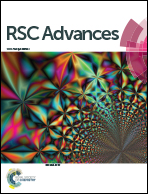Turn-off–on fluorescence probe based on 3-mercaptopropionic acid-capped CdS quantum dots for selective and sensitive lysozyme detection
Abstract
In this work, we presented a novel biosensor for rapid detection of lysozyme. The novel biosensor was based on the fluorescent “turn off–on” of 3-mercaptopropionic acid-capped CdS quantum dots (MPA-CdS QDs). Positively charged hemoglobin (Hb) could bind to MPA-CdS QDs via electrostatic interaction, which leads to the fluorescence of MPA-CdS QDs to “turn off”. Lysozyme is also positively charged, and it can replace Hb on the surface of MPA-CdS QDs. In the presence of lysozyme, the fluorescence of MPA-CdS QDs could be restored due to the displacement of Hb by lysozyme. The relative fluorescence intensity ratio F/F0 (F and F0 is the intensity of the MPA-CdS QDs–Hb system in the presence and absence of lysozyme respectively) showed a good linear relationship with the lysozyme concentration in the range of 15–600 nmol L−1 with a detection limit of 6.3 nmol L−1, the method exhibited remarkable selectivity for lysozyme in the presence of several other proteins. The presented method was cost-effective, convenient, and does not require any complicated synthetic procedures.


 Please wait while we load your content...
Please wait while we load your content...